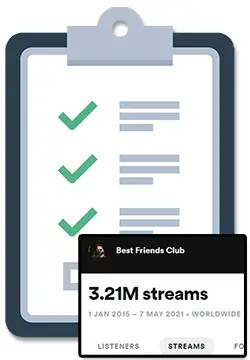In this post, I’ll show you how you can finally figure out the name of that genre you’ve been enjoying lately and how you can find more songs, artists, labels, and playlists in that music genre.
To find and learn a music genre, you need to uncover the main genre name, immerse yourself in all of the different sub-genres and different flavors, and finally understand the typical arrangement, structure, and instrumentation in that genre.
If you are just starting out, the best way to learn the genre of a song is to use a genre analyzer tool, a music chart or classification website, or to use artificial intelligence to create playlists filled with similar songs in Spotify.
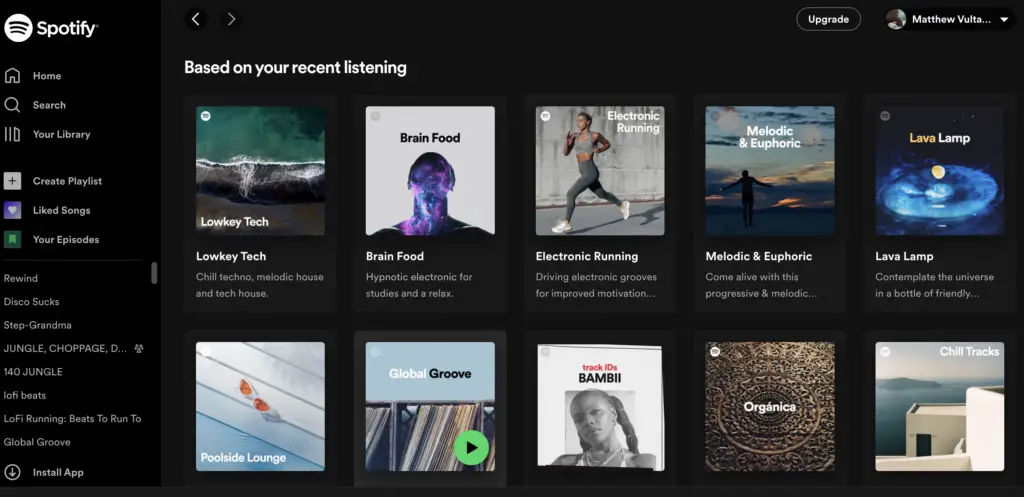
If you are more advanced, you can do what is called a DAW Deep Dive to get a detailed look at a song’s arrangement and structure. Although this is most useful for musicians, hardcore music enthusiasts may find it useful as well.
To learn more about how you can learn the genre of any song (from beginner to advanced techniques), simply keep on reading, my friend. 🙂
How To Know The Genre Of A Song
The best way to learn the genre of a song is to use a genre analyzer tool, a music chart or classification website, or to use artificial intelligence to create playlists filled with similar songs in Spotify.
As a musician, you can take this a step further by studying song’s in a given genre and mapping out their structure and arrangement in a Digital Audio Workstation.
More specifically, I’ve found there are 3 different levels to identifying and learning music genres. These levels start from “Level 0” which is when you don’t really know the details of a specific song or genre, but like it and want to learn more about it and find similar songs.
The 3 levels to knowing the genre of a song are:
- Music Genre Classification
- Music Genre Explorer
- Detailed Song Arrangement & Structure
Continuing reading this article to learn more about each level and specifically how you can start leveling up your music knowledge.
Music Genre Classification (Level 1)
Music genre classification is the first level of learning a music genre and is when you know the specific genre name and have a solid idea of any related genres and sub-genres around it.
The 3 main methods you can use to understand the classification of the music genre you are trying to learn are through a music genre analyzer tool, a website called Everynoise.com, a website called Beatport (for electronic music), and through specific Google/YouTube/Streaming Service searches.
Music Genre Analyzer Tool
One of the easiest ways to learn how to classify a music genre is to use a genre analyzer tool. These tools usually connect to Spotify and other popular music streaming platforms, allowing you to type in a song title so that the tool can tell you the name of its genre.

A music genre analyzer tool is a great and easy way to find out a song’s genre quickly but may be less effective for more niche or less popular songs and genres.
Popular music genre finders include: Chosic.com, Last.Fm, and Allmusic.com.
The 7 Best Music & Song Genre Analyzers are:
- Chosic.com
- Last.FM
- Getgenre.com
- Heroku Genre Analyzer
- Allmusic.com
- Finalizer.com
- Organize Your Music
These music genre analyzers are basically apps that help you identify genres so that you can have a better understanding of what music you like.
Everynoise For Spotify
Every Noise At Once (or Everynoise.com) is a website that maps every music genre that exists by creating algorithmically generated scatter-plots of music genres based on data tracked in music streaming services.
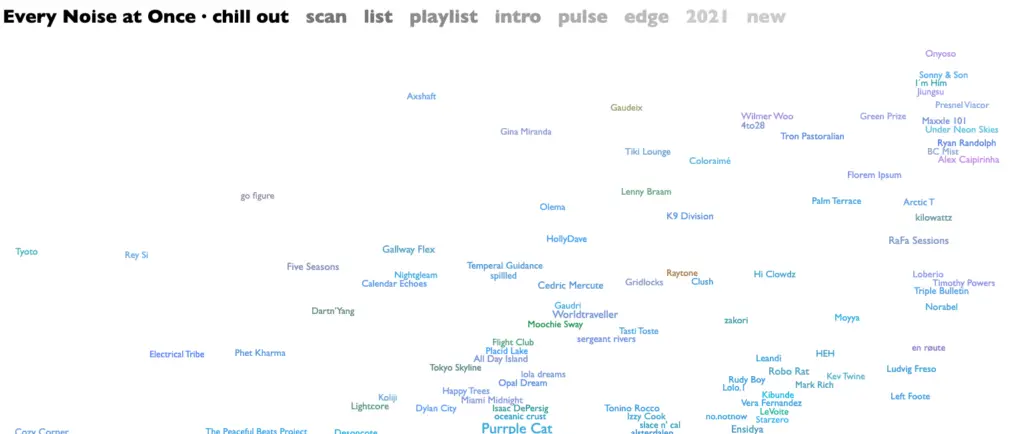
By gathering all of the song data from Spotify and creating their own little charts of similar artists and different genres, Everynoise.com makes it easy to find related artists and genres.
In addition to this, there are very cool EveryNoise-created Spotify playlists that have genre-specific playlists based on popular or trending songs in that genre. They even have a playlist of songs that are almost outside of the genre as well.
Beatport For Electronic Music Genre Discovery
Beatport is a website for electronic music genres like house, techno, and dance music that is great for music discovery because they have music charts for a lot of dance music and different sub-genres of dance and electronic music.

If you’re trying to identify a genre in that realm of electronic music and dance music, Beatport is a great way to go.
Google, YouTube & Streaming App Search Engines To Find Genres
The search engines built into websites like Google, Youtube, and streaming services like Spotify are always a good way to discover music genres.
In addition to the search function, most of these websites have a recommendation engine and will show related artists, songs, and genres in your search results.
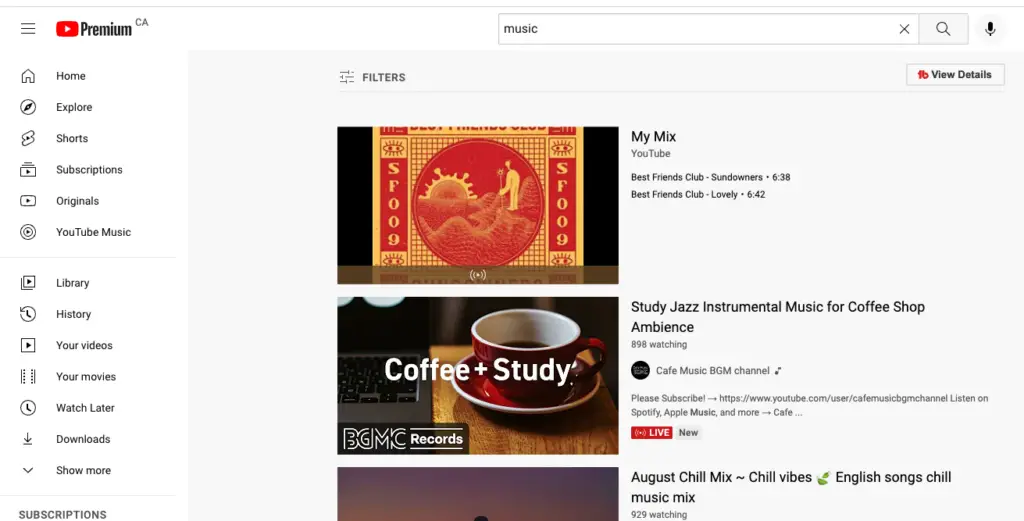
All of those tactics are a great way that you can get to know the first idea of what a genre is and start to dip your toes into a new style of music.
Next up, you will learn to really understand and immerse yourself in the new genre you have begun to learn.
Music Genre Explorer (Level 2) – How To Find New Music You’ll Like
Level 2 of understanding and identifying and learning any kind of music genre is all about really immersing yourself in that genre.
This is the point where you’re going to find out all of the different sub-genres and different flavors of the main genre that there are.
Here are the 7 best ways to find new music you’ll like:
- Get recommendations from Spotify’s algorithm
- Look up “best of” genre and mood playlists
- Explore music genre documentaries
- Watch interviews with your favorite artists to discover their influences
- Follow music review social media profiles and websites
- Attend local shows and concerts in your area
- Ask your friends for suggestions
In addition to finding new music, you may dive into a bit more of a history of how that genre came to be and any kind of other music that may have inspired it or made it what it is today.
A big part of this stage is really just immersing yourself in this genre and doing a lot of extra research both in exploring the music as well as outside of the music.
The Automatic Spotify Playlist Maker Technique
The Automatic Spotify Playlist Maker Technique is done by simply adding 5 – 10 songs in a specific genre that you are really liking into a new playlist in Spotify.
From there, you can scroll down to the bottom of the playlist and Spotify will actually suggest very similar songs and artists:
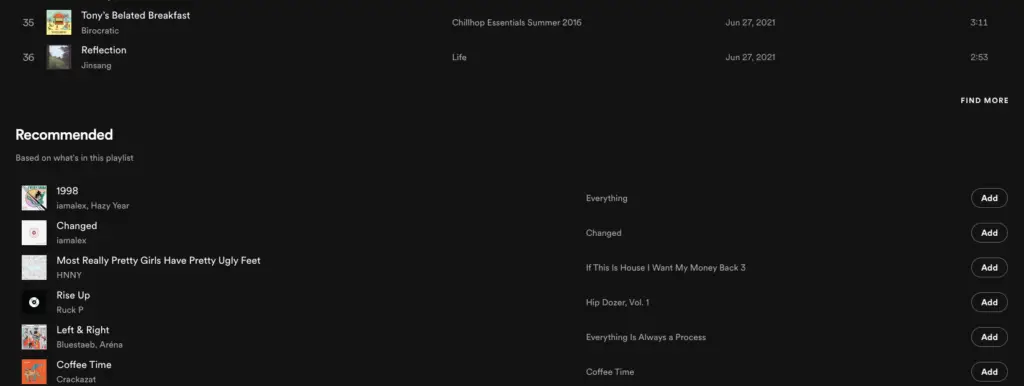
This is a very useful technique and can really get you to Level 2 in your quest for music genre knowledge.
By leveraging Spotify’s algorithm and extremely in-depth data on music and all of its user’s listening habits, you will be able to find music that is extremely similar to the music that you first added to your playlist.
In fact, it’s almost scary how powerful their algorithm can be. Definitely try this technique out.
This is really is a simple and fantastic way to really dive in deeper and find out similar genres, artists, and songs to really get a better understanding of who makes music in the particular genre you are researching.
Spotify Best Genre Playlists
In addition to creating your own playlists and leveraging the Spotify algorithm to find more music, you can also start following other Spotify playlists that feature the songs and artists you’ve already found or discovered.
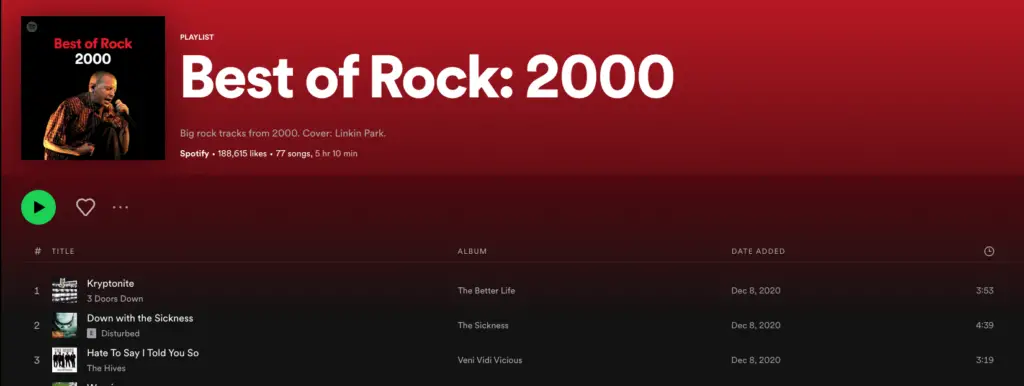
Spotify actually has its very own official playlists curated by their very own Spotify editorial team that usually focus on a genre or mood.
Free Music Genre Documentaries
An increasing amount of free music genre documentaries can be found on YouTube. Although they are unofficial documentaries created by YouTube creators, you can really learn a lot about a genre or artist by watching a video that someone has made after doing their own in-depth research.
This is specifically useful as a way to start looking at the origin of a specific genre or sub-genre. There’s a good chance that someone’s put together a really cool documentary or video on the history and origins of a specific genre regardless of how big or small.
Detailed Song Arrangement & Structure (Level 3)
Lastly is level three of this process of identifying and understanding any music genre. This is level is really aimed towards musicians and artists because this is where you would break down the actual structure of some of these songs inside of this genre to the point where you can actually create music like that yourself.
With that said, if you are just a really, really dedicated music enthusiast you may also find this interesting.
Personally, the way that I usually do this is with something called a DAW Deep Dive. DAW stands for Digital Audio Workstation and it is a program that you install on a computer to make music.

Here are the steps you need to take to do a DAW Deep Dive to get a detailed look at a song’s arrangement and structure:
- Download 2 or 3 of your favorite songs in any one of the genres that you’re trying to learn
- Drop a song into your DAW of choice
- Create a new track for each instrument you hear (drums, guitars, vocals, etc)
- Following the song, add clips across the timeline to indicate where different instruments come in and out
You can go into as much or as little detail as you like. The more detail you go into, the more you will be able to identify the different sections of the song so from doing this you’ll get an extremely deep dive into any specific song in a genre.

By doing this for multiple songs within a genre, patterns and themes in how the songs are organized from the beginning of the song to the end of the song as well as the different textures and sound design the instruments that go into the specific genre will begin to become clear.
This is super useful if you’re a musician trying to learn a new genre because by doing this technique you can get an extremely deep level of detail into that genre and be able to do your own great take on that style.
How I Learn & Study Different Music Styles
The whole reason I am mentioning any of this is because I do this myself whenever I’m starting to learn any kind of new genre or starting up any new project.
If you did not know, I actually make music under the name Best Friends Club and it’s more of a lo-fi house, deep house, dance music, etc.
More specifically, I’m bringing this up now because I’m starting to figure out how I want to release more of a chill kind of lo-fi style of music and one of the first steps that I personally have started when trying to figure out how I can start releasing music in this style is doing the things I mentioned in this article.
So first I figured out what the genre was and then dug into it deeper to discover the sub-genres and the different flavors of the genre.
What I noticed is that what I particularly like is a sub-genre called chill hop and jazz hop. So then from that deep dive I learned a lot more artists in that specific real, was able to find the top songs that I particularly like that I want to emulate, and then figure out exactly how they created the sounds and songs. This way I could borrow those techniques in my own music.
I put together about 20 or 30 tracks to do the DAW Deep Dive and was able to get a really good understanding of the different instrumentation and song structures that goes into the style of music that I’m trying to create. This then allows for a great kicking-off point for when I start to create similar music myself.
It just makes it a lot easier to get involved in that genre and always results in a more professional end result because you’ve done the research and you have put in the time instead of just hoping that you come up with something “good enough”.
…so what do you do after the music is created?
How To Upload To Spotify As An Artist (& Get Paid)?
Want to upgrade from just listening or writing music to actually get your own music on Spotify and becoming an official Spotify artist?
To upload to Spotify as an artist, you need to sign up with one of Spotify’s preferred music distributors and submit your music, artwork, and artist information through that distributor.
Thankfully it’s easy for anyone to upload music to Spotify because a company called DistroKid came along and started offering unlimited song uploads for a small annual fee without taking a percentage of any of your earnings away.
Before DistroKid, it was too expensive and complicated (..you had to pay PER song EVERY year).
To learn more about DistroKid, check out my big fat DistroKid review for everything you will ever need to know about them. There is even a handy How To Choose A Distributor Guide and some info on the nice DistroKid discount.
If you are wondering want to know more details about how to do this yourself, how exactly you can claim your artist profile, and actually make some money by uploading music to Spotify, check out my article called How To Upload To Spotify As An Artist (& Get Paid)

